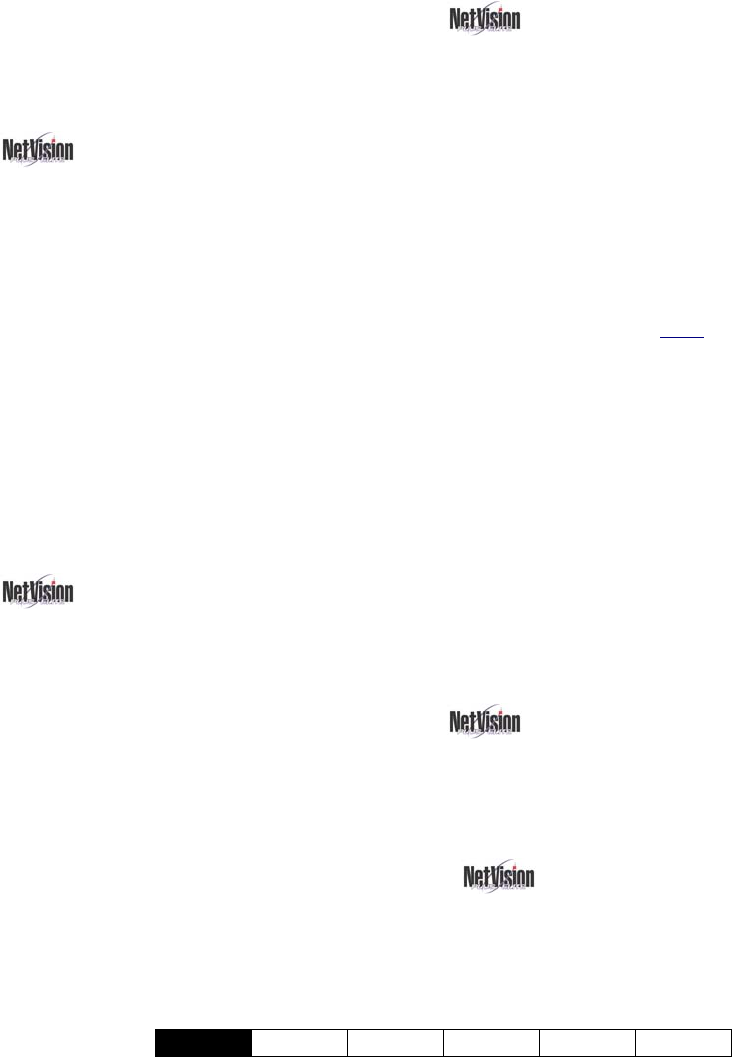User`s guide
Table Of Contents
- Copyrights and Trademarks
- Disclaimer
- Welcome to NetVision
- Common / Daily Tasks
- 5 Starting your Software and Logging In
- 6 Alarm / Reporting Features and 'Chatting'
- 7 Playing or Downloading Video Recordings
- 7.1 Overview--Types of Playback
- 7.2 Playback--Technical Details
- 7.3 Synchronized Playback (v2.3 SP2)
- 7.4 Video Search (v2.3 SP2)
- 7.5 Searching for Motion
- 7.6 Working with the Playback Screen
- 7.7 Viewing and Printing 'Snapshots'
- 7.8 Working with the File List
- 7.9 Quad Playback
- 7.10 Server Management--Identifying Remote Servers for Playback
- 8 Viewing Live Cameras
- 9 Recording Camera-Views
- System Administration and Maintenance
- 10 Tasks Applicable to Remote Stations and the Video Server
- 10.1 PC Date and Time
- 10.2 Checking your Software Version
- 10.3 Introduction to Video File Management (Filekeeping and Housekeeping)
- 10.4 To Allow Using a Blank CD (Roxio - Easy CD Creator 5 basic with DirectCD)
- 10.5 Filekeeping (v2.3 SP2)
- 10.6 Housekeeping
- 10.7 Automatic Video File Management (Self Housekeeping)
- 11 Tasks Performed at the Video Server Only
- 10 Tasks Applicable to Remote Stations and the Video Server
- System Configuration
- Software Installation and Network Set Up
- 19 PC Requirements
- 20 Software Installation or Upgrade
- 21 Network and Connectivity Issues
- 21.1 General Network Requirements
- 21.2 IP Addressing on the Network
- 21.3 Network Services
- 21.4 Network Ports
- 21.5 To Connect via the Internet
- 21.6 Remote User Permissions
- 21.7 For Remote Viewing, Recording, Playback, and/or Audio Monitoring
- 21.8 For Alarm Alerts
- 21.9 For E-Mail Alerts
- 21.10 Windows Dial-Up Networking Connection (i.e., not via the Internet)
- 21.11 Network Usage
- Reference Topics
- 22 Using the Small Remote Module
- 23 Remote Configuration
- 24 The WatchDog Feature
- 25 Hardware Reference
- 26 Troubleshooting
- 27 Using the ATM Interface Option
- 28 Working with the Older Playback Engines
- 28.1 The Video Playback Feature (Micro DVR)
- 28.2 Step 1: Open the Video Player
- 28.3 Step 2: Local / Remote, and Connection Screen
- 28.4 Step 3: Searching for Video/Alarm Files
- 28.5 Smart Motion Search (Micro DVR)
- 28.6 Step 4: Playing a Video
- 28.7 Window Options and File Properties (Micro DVR, Quad Player)
- 28.8 Viewing and Printing 'Snapshots' (Micro DVR)
- 29 Viewing Cameras through a Web Browser
- 30 Setting up an IP Camera or Video Server module (v2.3 SP2)
- 31 Panoramic Video Surveillance--PVS (v2.3 SP2)

21-0400E v2.3.3
Welcome
Common Admin Config Install Tech-Ref
5
• NetVision Video Servers will include up to
five audio inputs—allowing audio to be
included with camera images and monitored
at authorized remote stations. (Systems
include a built-in sound card with
microphone jack, plus up to 4 line-level
audio inputs (on video capture boards, or an
optional 4-input audio board).
•
Audio can be monitored at remote
stations. This allows sounds associated with
a camera to be heard (and included in
recordings). This also allows an operator to
'broadcast' verbal instructions to remote
stations that are 'on-line'
(via PC or camera
microphone; controlled through remote user
permissions)
.
• Each camera can be triggered to auto-record
by an external sensor, or motion being
detected in the camera's view (configurable
including detection zones). Each camera
can also be set for ‘pre-alarm’ recording so
the scene is available showing up to 300
seconds before the alarm occurred.
• Motion sensing and/or recording can be
scheduled to occur at specific times.
(Recording can also be done manually, at Video
Server PCs and remote stations.)
•
Alarms (external sensors, video
motion detect, and/or video/signal lost—
where applicable) can:
+ Trigger a camera to display automatically (V2.3
SP2)
+ Trigger an associated PTZ camera to jump to a
pre-defined PTZ preset position
+ Signal a remote surveillance station (with or
without: A custom sound being played; 5-10
frames being displayed; The live camera being
auto-displayed, and/or; The camera being auto-
recorded.)
+ Signal an e-mail recipient (with or without a
'snapshot' image).
+ Activate special "Alarm Overlay" subtitles (v2.3
SP2).
• Alarms can trigger external device(s)
through one of three built-in outputs (one for
external sensors triggered, one for video
motion-sense, and one for either/both).
•
Netvision users can 'chat' on-line
with Video Server operators.
• The following items can be logged at a Video
Server:
+ Motion-detection and video lost alarms that occur;
+ Changes being made by operators using the
[Utility] menu;
+ Remote video playback sessions.
+ HTTP server activity (v2.3 SP2).
• The watchdog feature causes the Video
Server to restart automatically if the
Netvision software stops responding for a
pre-set duration (60-250 sec.).
With the hardware watchdog option, the Video
Server will be restarted in the event of MS Windows
'hanging' or 'crashing' as well.
• Built-in HTTP server;
• Web/browser-based viewing of camera
images, controlling PTZ cameras, and
recording remotely is provided through the
Webcam and/or WebView features.
• Remote (browser-based) configuration of
many items including motion detection set
up;
• Selectable recording CODEC (compression
and file-type) at Video Server PCs and
remote stations;
• Video files are encoded to help allow the
detection of image tampering.
•
SiteWatch™ software allows
monitoring the status of NetVision Video
Servers remotely.
• File management tasks can be performed
manually, or automated and scheduled
through the “Self-Housekeeping” feature.
+ (v2.3 SP2): New "Filekeeping" feature
allows viewing or adding a remark, plus
previewing, downloading, and maintenance
functions.










